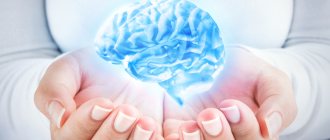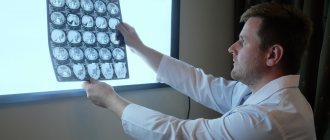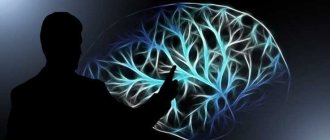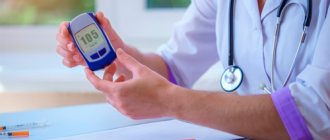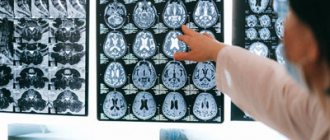21.05.2013
Maltseva Marina Arnoldovna
Head of the consultation department - neurologist, specialist in the field of extrapyramidal pathologies, doctor of the highest category
The human brain is the crown of development of human nature, allowing us to develop and transform our own lives in accordance with our goals. We owe most of the body functions responsible for our life to the work of the central nervous system. The human brain is an incredibly complex organ that leads to the coordinated functioning of almost all systems in the body. not to mention the higher nervous activity responsible for cognitive skills and thought processes. Unfortunately, a fast pace and far from the healthiest lifestyle slowly undermine the body, depleting its reserves and compensatory mechanisms. Today, the world faces an acute problem associated not only with high morbidity, but also with disability and even mortality from cardiovascular diseases. Among such diseases, organic brain damage of an ischemic and hemorrhagic nature is in the first place. It is important to note that despite the significant preponderance in the morbidity structure of people in the older age group, namely 45 years and older, organic brain damage can also occur in children.
A brief excursion into the anatomy of the central nervous system
The human brain is a complex organ responsible for the functioning of the entire organism. There is a clear hierarchy in the structure of the brain, which allows the entire body to work effectively. The central nervous system can be divided into several main parts:
- The cerebral cortex is responsible for higher nervous activity, i.e. thought processes, speech, memory, writing, hearing and many other functions.
- Subcortical structures that form the midbrain. The midbrain is responsible for the primary reflex units and the formation of unconditioned reflexes.
- The bridge is a connecting link between all parts of the central nervous system and the cerebral cortex.
- Cerebellum. It is located in the lower occipital part of the head and is responsible for human coordination in space.
- The medulla oblongata connects the brain with the spinal cord and is its continuation. The medulla oblongata contains vital centers: vasomotor and respiratory.
Diagnosis of Alzheimer's disease
Patients are not always able to notice and understand changes in their body, so relatives need to bring a loved one to the doctor at the first manifestations of pathology. A neurologist diagnoses Alzheimer's disease. During the examination, he determines the level of the patient’s reflexes, conducts a series of tests to assess cognitive functions, establishes anamnesis, and the presence of provoking factors.
The set of examinations includes:
- General blood analysis. The results provide information about the presence of concomitant diseases and inflammatory processes in the body. It is recommended to do a detailed clinical analysis for the content of folic acid and vitamin B12.
- Biochemical blood test. Dementia can be caused not only by Alzheimer's disease, but also by a number of endocrine disorders and thyroid dysfunction.
- Blood test for HIV, syphilis, and other infections. The pathogen in the body worsens the patient’s condition and accelerates the course of neurodegenerative processes.
- Electroencephalography (EEG). The essence of Alzheimer's disease is the destruction of neurons and disruption of the conduction of nerve impulses. The EEG will show diffuse slowing of the signal.
- Computed or magnetic resonance imaging. The photographs show areas of atrophy of the cerebral cortex and senile plaques. Based on the results of MRI, differential diagnosis of pathologies such as hematomas, neoplasms, and strokes is carried out.
- CSF analysis. In Alzheimer's disease, an increased level of amyloid is detected.
- Genetic analysis. The presence of a mutation in the ApoE gene, the defect of which causes dementia, is detected.
What is brain damage?
Organic brain damage is primarily a symptom of a disease, manifested by disruption or loss of a number of functions as a result of the pathogenic effect of some factor on brain tissue. The etiology of brain damage can be very diverse, and this will be discussed in more detail later in the article. Organic damage means that brain cells - neurons - are exposed to a variety of influences, which lead to the formation of dystrophic processes inside neurons and disrupt their functional activity. In the most serious cases, neurons simply undergo first necrobiosis and then necrosis, i.e. are dying. The death of a large number of neurons localized in a single anatomical space leads to the loss of one or another function in the body of the affected person, and the identification of a disturbed function allows specialists to understand in which part of the brain the catastrophe occurred - this is called topical diagnostics. Symptoms of organic brain damage in children manifest themselves differently than in adults, since the full activity of the higher nervous system has not yet been formed. Children may experience delays in mental, mental and physical development, unstable mood and behavioral abnormalities.
Pathogenetic mechanisms of neuronal damage
A number of mechanisms of different nature can lead to organic damage to the brain. This pathological condition can be provoked by both external and internal factors, and this must be taken into account, since therapeutic measures, depending on the pathogenetic type of development of damage to brain neurons, will differ radically.
Violation of energy supply
The most common pathogenetic variant of brain damage is associated with an imbalance between the need of neurons for energy and its entry into the cell. Energy deficiency can develop due to insufficiency:
- Nutrients in the victim's body, for example as a result of hypoglycemia, when there is not enough glucose in the blood;
- Oxygen, which causes a condition such as hypoxia. Brain hypoxia causes damage to nervous tissue and often occurs in acute ischemic or hemorrhagic cerebrovascular accidents. In children, brain hypoxia can develop in the antenotal period and during childbirth, which leads to anoxic brain damage in the child.
- When the concentration of potassium, calcium, sodium and chlorine ions increases or, conversely, excessively decreases, transmembrane proteins may malfunction, which also entails energy deficiency inside the cell.
It is worth noting that energy deficiency leads to rapidly progressive damage to brain tissue and within 5-7 minutes, in the absence of sufficient oxygenation, neurons begin to experience acute hypoxia and die. Damage to the blood vessels of the brain has the following symptoms:
- The patient notes memory impairment;
- There is a decrease in vision and hearing;
- The synthetic activity of the brain slows down;
- When performing angiography of cerebral vessels, multiple stenoses of cerebral vessels can be detected;
- MRI of the brain shows dystrophic disorders and a decrease in the volume of the cerebral cortex.
All of the above symptoms are signs of systemic atherosclerosis, which affects most older people. Atherosclerosis leads to the formation of discirculatory encephalopathy.
Traumatic injuries
Injuries are always associated with mechanical damage to the brain and the subsequent development of edema, which leads to an increase in intracranial pressure. Since the brain is located in the cranium and literally floats in the cerebrospinal fluid - intracerebral fluid, the consequences of blows and bruises become serious. Despite. The cerebrospinal fluid plays a protective and shock-absorbing role; with the development of a brain contusion, an increase in intracranial pressure occurs, since the fluid is not physically compressible. Brain cells are exposed to excessive pressure and begin to die. Brain tissues occupy up to 96% of the volume of the cranial cavity, which makes this organ very sensitive to changes in intracranial pressure.
It is very important to note that quite often injuries are accompanied by internal hemorrhage, which can lead to the formation of an extensive hematoma and displacement of the brain. Dislocation of the brain leads to wedging of its subcortical structures into the foramen magnum, which inevitably leads to the death of neurons located in the nuclei of the vasomotor and respiratory centers, without which the life of the victim is impossible.
Infectious
Brain damage can be caused not only by physical factors. But also biological. Conditions such as meningitis, encephalitis, and ventriculitis can significantly impair the functional activity of the brain.
- Meningitis is an inflammation of the lining of the brain. Etiological factors can be very diverse, so the brain can be affected by many bacterial and viral diseases. Inflammation of the membranes of the brain can occur primarily through direct infection through the wound gate. And secondarily – as a result of an immunodeficiency state.
- Encephalitis is inflammation of the brain tissue itself. Encephalitis is an even more severe infectious disease than meningitis. As a result of encephalitis, purulent melting and liquefaction of areas of the brain can occur, which leads to the formation of persistent disturbances in the functioning of various organs of the victim. With encephalitis, brain damage very often leads to disability or even death.
- Ventriculitis is an inflammation of the integumentary tissues lining the ventricles of the brain. This disease occurs in newborns and infants and leads to increased intracranial pressure and the development of hydrocephalus due to insufficient drainage function of the cerebrospinal fluid.
The brain can be affected by both specific and nonspecific infectious agents; this is important to consider when prescribing treatment, since antibacterial therapy regimens will vary.
Congenital pathology
Anomalies of brain development can form in the very early stages of a child’s development. The first trimester of pregnancy is the most dangerous for the woman and the fetus, since the pregnant woman’s body and the fetus are unprotected from external factors, and at the time of the initiation and formation of organs, the most dangerous anomalies and gross developmental pathologies can form, for example micro or acephaly.
Toxic damage
Not the most common type of brain damage, but nevertheless it does occur. Brain damage occurs if the chemical has neurotoxic properties and is able to cross the blood-brain barrier. Neurotoxic agents lead to organic damage in various parts of the nerve cell; most often, neurons suffer from disruption of the transmembrane transfer of nutrients and disturbances in the synthesis of neurotransmitters. Toxic injuries of varying severity can lead to both persistent encephalopathy and complete loss of some functions of the person affected by intoxication. Most often, gross organic damage to the brain is caused by substances such as arsenic and nitrogen metabolism products, with excessive accumulation of the latter in the blood plasma.
Oncological diseases
Brain damage in oncology can be primary. When a tumor develops directly from brain tissue or secondary - when atypical tumor cells are metastatically introduced into the brain.
Vascular aneurysm
This head disease poses a great danger to human life. During its development, there is a loss of elasticity of the blood vessels in the brain, which is why they can rupture. And this causes bleeding in the brain.
Pathology may appear due to a hereditary or acquired defect in the walls of an artery or vein. The particular danger of the disease is that in the initial stages and until rupture, it does not manifest itself in any way. If a rupture occurs, it is very difficult to save the person, so it is very important to monitor your health and undergo regular examinations. This brain pathology has increasing symptoms. Among the main ones are:
- migraine;
- feeling of weakness even with light exertion;
- vomiting, nausea;
- negative reaction to noise and light;
- speech disorder;
- numbness of any part of the body;
- paresis and swelling;
- visual disturbances.
If such symptoms appear, you should immediately consult a doctor. If the diagnosis indicates the presence of an aneurysm, then the most effective treatment method will be surgery. This operation will strengthen the vessels and block the neck of the aneurysm.
Types of brain lesions
Brain damage can be either focal or disseminated. Let's figure out what focal brain damage is. This is a condition in which there is a clearly demarcated single focus with necrotic tissue, i.e. This is a local brain lesion. This type of damage often occurs during acute cerebrovascular accident.
Disseminated or multifocal brain damage is a type of injury in which multiple scattered foci of damage to brain tissue are detected. The multifocal form occurs in infectious diseases of the brain, for example, when an infectious agent is introduced hematogenously into the medulla or with an oncological lesion.
Causes of diseases
At first, almost all brain diseases occur without visible symptoms, so they can be identified in the final stages, when it is no longer possible to help the person.
The reasons for the development of such pathologies may lie in:
- Infectious diseases, for example, AIDS, rabies, etc.
- Skull injuries.
- The effects of harmful chemicals on the human body.
- Radioactive radiation.
- Bad habits (alcohol, smoking, drug addiction).
- Unbalanced diet.
Treatment tactics
Treatment of organic brain damage can be very diverse and depends on the pathogenetic mechanism of development of the damage and the immediate cause.
Treatment of organic brain damage can be surgical and conservative. For example, the development of high intracranial pressure, which poses a threat to life, can be treated both surgically and conservatively. Surgical treatment - the application of a burr hole for brain decompression is applicable in the formation of a severe hematoma due to trauma or hemorrhagic stroke, and conservative therapy is possible with a moderate increase in intracranial pressure without brain dislocation. For conservative therapy, diuretics are used that cause forced diuresis, allowing for the rapid elimination of edema.
Treatment of cerebral artery atherosclerosis can also be either surgical or conservative. Surgical – angiography with the installation of stents to widen the lumen of the arteries. Conservative – antithrombotic therapy and correction of dyslepidemia.
Clinical Brain Institute Rating: 4/5 — 16 votes
Share article on social networks
Treatment of Alzheimer's disease
Drug treatment
The doctor prescribes symptomatic therapy. It is important to alleviate the patient’s condition as much as possible, to help him retain memory and attention longer, and to increase life expectancy.
Drug treatments for Alzheimer's disease include:
- Cholinesterase inhibitors: rivastigmine, donepezil, haoantamine.
- NMDA-glutamate receptor blockers: akatinol-memantine.
The drugs are included in the list of vital drugs, their purchase is financed from the budget. When prescribed in the early and middle stages, medications help stop the progression of the disease.
To treat concomitant disorders, the doctor prescribes antipsychotics, antidepressants,
Social rehabilitation
It is important to maintain the patient’s usual lifestyle for as long as possible. Intellectual regression will be steady, but doing what you love and hanging out with friends will help slow it down. A person with Alzheimer's disease often lives “in the past,” so relatives are advised to discuss current events with him as much as possible and remind him of certain facts. If the patient was drawing or playing a musical instrument before diagnosis, let him continue. Active intellectual activity and movement stimulate the formation of new connections between neurons and use brain reserves, which helps resist dementia.
In many large cities, “schools for relatives” have been opened. The essence of the classes largely boils down to psychological support, but as part of the training they provide a lot of valuable information on caring for people with Alzheimer's disease. The attention of relatives is an important aspect of the social rehabilitation of each patient.
Some rules for caring for a person with dementia:
- As memory deteriorates, teach the patient to use simple paper notes. Everything in the room must be signed. Post detailed instructions for daily tasks, lists with meal times, etc. in visible places.
- Establish a clear daily routine. Breakfast, lunch, dinner, hygiene procedures - everything should be done at the same time. This contributes to the formation of “muscle” memory when a person acts automatically.
- Find something feasible for the patient to do. Many older people like to knit, read newspapers, and do crossword puzzles.
- Stay calm when communicating. You cannot shout at the patient, swear, or use physical force. With severe dementia, a person’s character and personality change greatly, but he does not behave this way on purpose, but because of his illness.
- Allow the patient to serve himself as much as possible. It is important for a person to feel his independence. You don't need to do all the household chores for him. The patient can wash the dishes or make the bed himself, even if it takes twice as long as usual.
- Make your surroundings safe. It is worth removing cutting and piercing objects from the room and leaving a minimum number of electrical appliances. As Alzheimer's disease progresses, patients tend to act rashly.
An integrated approach to treatment allows patients to maintain a fairly clear mind and the ability to self-care until old age. Life expectancy after diagnosis reaches 14 years or more. Relatives are advised to use the services of specialists, especially in the later stages of Alzheimer's disease. Professional care for a patient in a boarding house or hospice will significantly improve his well-being and allow the family to return to work and their normal lifestyle.
Programs:
Assessment of rehabilitation potential
Movement restoration
Restoration of cognitive functions
Early (resuscitation) rehabilitation
Rehabilitation after strokes and injuries
Prevention of Alzheimer's disease
It is impossible to predict and prevent neurodegenerative changes in the brain in advance. But you can reduce the risk of their development. It has been proven that people engaged in intellectual work are less likely to suffer from dementia. A good prevention of Alzheimer's disease are special gymnastics and exercises for mental mobility. It is recommended to read books, solve crosswords, and engage in scientific activities as far as possible until old age.
Maintaining mental balance is one of the effective methods of preventing dementia. Stress and nervous tension should be avoided. Physical activity, frequent walks in the fresh air, and proper nutrition help improve overall health.




